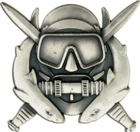 Military Scuba Diver Badge, retired in 2004
Military Scuba Diver Badge, retired in 2004 Current Army Special Operations Diver Badge
Current Army Special Operations Diver Badge
Special Forces Underwater Operations (SFUWO) is the term for United States Army Special Forces combat operations involving the use of underwater infiltration methods. These typically involve the use of closed circuit dive equipment to infiltrate a beach landing site (BLS) undetected. The US Army Special Forces, also known as Green Berets have been conducting maritime operations and underwater operations since their founding in 1952. Currently, each company within a Special Forces Group mans, trains, equips, and deploys a SFUWO Operation Detachment Alpha (SFOD-A). These twelve-man teams train for SFUWO as their primary infiltration method when conducting one of their missions of unconventional warfare, direct action, counter-terrorism, foreign internal defense, among others.
Special Forces Underwater Operations School Overview (2015) (2:52)
US Army Special Forces first existed within the Office of Strategic Services (OSS) Operational Groups. Army Green Beret Combat Divers were first in the OSS Maritime Unit. The Lambertsen Amphibious Respiratory Unit (LARU) was the first closed-circuit re-breather adopted by the US Military and used in Combat Operations with the OSS MU. It was invented by Dr. Christian Lambertsen. Army Special Forces have been conducting these operations for nearly seventy years. The Army Special Forces fielded Special Operations Combat Divers with detachments conducting SFUWO in the early and mid 1950s, nearly a decade prior to the creation of the Navy SEALs. Archival footage from this time period depicts an Army Special Forces detachment conducting advanced underwater operations including underwater infiltration, submarine lockout procedures, and underwater demolition.
Special Forces Underwater Operations School
The US Army Special Forces founded the Special Forces Underwater Operations School in Trumbo Point Annex, Naval Air Station Key West, in 1964. Prior to that SF Detachment-Alphas were receiving disparate levels of dive training at their respective groups. SFUWO makes up C Company of the 2nd Battalion, 1st Special Warfare Training Group at the U.S. Army John F. Kennedy Special Warfare Center and School.
Army, Navy, Air Force, and Marine Corps personnel have previously attended the Combat Diver Qualification Course (CDQC), the seven week course that trains special operators to conduct SFUWO in a combat environment. With a cadre of instructors primarily made up of Army Special Forces, along with a smaller number of Army Rangers, Navy SEALs, and Air Force pararescuemen and combat controllers, CDQC was formerly a standard part of the Air Force pararescue and combat control training pipelines (prior to the opening of the USAF Combat Diver Course in Panama City, FL), and both Tactical Air Control Party and Special Reconnaissance (formerly Special Operations Weather Teams) have also attended CDQC to become qualified in special warfare maritime operations.
See also
- Army engineer diver
- United States Marine Corps Combatant Diver Course
- Underwater Construction Teams
- Military diving
- Uniform Service Diver Insignia (United States)
References
- "FM-3-05-212 Special Forces Waterborne Operations". US Army APD. Retrieved 3 May 2019.
- ^ "The Big Picture," Pictorial Report No. 29, TV-372; U.S. Army; courtesy of PublicResourceOrg; circa 1956; last accessed 28 November 2022
- "OSS Maritime Unit". OSS Maritime Unit. Archived from the original on 27 October 2020. Retrieved 3 May 2019.
- "Christian Lambertsen and the Secret Story Behind Scuba". CIA Library. Central Intelligence Agency Library. Archived from the original on August 26, 2017. Retrieved 3 May 2019.
- ^ Crippen, Linda. "Combat Diver Qualification Course challenges Special Forces". US ARMY. US ARMY TRADOC. Retrieved 3 May 2019.
| United States Army Special Forces | |
|---|---|
| Historical predecessors | |
| Command | |
| Active Groups | |
| Inactivated Groups/Units |
|
| See also | |
| Badges of the United States Army | |
|---|---|
| Special Skill Group 1 | |
| Special Skill Group 2 | |
| Special Skill Group 3 | |
| Special Skill Group 4 | |
| Special Skill Group 5 | |
| Special Skill Group 6 | |
| Identification | |
| National Guard and Other | |